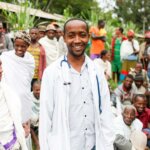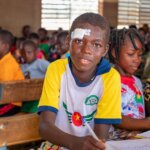- Disability Rights
From Kenya to South Sudan, inclusive climate action is transforming lives. As the world looks towards COP30, it’s time to scale these solutions and debunk climate myths — proving that disability inclusion and eye health are central to climate justice.
The climate crisis affects us all, but not equally.
People with disabilities are particularly impacted by, and vulnerable to, the climate emergency. Yet, they are still largely marginalised in climate action. At the same time, addressing environmental degradation and the climate crisis is becoming increasingly urgent.
Here are four climate myths that need busting to ensure climate action is sustainable, inclusive and effective.
Climate Myth 1: “the climate crisis does not impact our health”
Busted.
The World Health Organization calls the climate crisis a “fundamental threat” to human health. Rising temperatures, extreme weather events, vector-borne disease and disruption of food systems all worsen health conditions and disrupt medical services.
Climate risks are accelerating, with 3.6 billion people already living in highly climate-vulnerable areas. Lower-income countries and small island states — despite contributing least to global emissions — bear the brunt of the health impacts, facing death rates from extreme weather up to 15 times higher than in less-vulnerable regions.
People with disabilities are already more vulnerable to service disruption and exclusion from health planning and face even greater barriers when health systems are unprepared for climate shocks.
In Kenya’s semi-arid Meru County, farmer and disability advocate, Lydia Wanja, has seen firsthand how the climate crisis threatens health and livelihoods.
Droughts, failed harvests and long treks for water once left families without enough food and children out of school.
Today, Lydia runs a climate-smart farm using greenhouses, drip irrigation and solar power to cope with erratic rainfall and extreme heat.

“When there’s no rain, we harvest water from our greenhouses and reuse it,” she says.
“We grow tomatoes, not because of the cash flow, but to empower our women in the community on how they can grow their own gardens and to maintain good health for their families.”
Her story shows how inclusive, sustainable farming can protect health and climate resilience if people with disabilities are part of the solution.
Climate Myth 2: “the climate crisis affects everyone equally”
Busted.
People with disabilities are usually among the most excluded and forgotten in humanitarian responses to disasters and emergencies. As a result, they are more likely to die than those without disabilities, be injured and suffer property damage.
Thirty-nine per cent of people with disabilities have a lot of difficulty or cannot evacuate during a sudden disaster, according to the UN’s flagship 2024 report on disability. More than one in four need to evacuate but have no one to assist them.
When unprecedented floods hit South Sudan in 2024— affecting over a million people and displacing hundreds of thousands — people with disabilities were disproportionally affected. In Jonglei State, roads were submerged and tricycles or wheelchairs became ineffective in flooding.
Disability inclusion must be a central part of disaster-planning, early-warning systems, accessible shelters and evacuation schemes.
Light for the World worked with Disability Inclusion Facilitators to train parents of children with disabilities, community leaders and local government officials on disaster preparedness and resilience as part of the We Are Able project.

Athiei John, a DIF in Jonglei State, says: “We have been experiencing many challenges due to floods. But now, with the knowledge we’ve gained, we can plan with our stakeholders and raise awareness in the community about disaster risk management, especially for people with disabilities.”
Climate Myth 3: “it is too expensive to be environmentally sustainable”
Busted.
In Kenya’s Laikipia County, an innovative, cost-effective idea is protecting livelihoods and ecosystems.
As droughts drive elephants closer to human settlements, people with disabilities — working with Light for the World, Organisations of Persons with Disabilities (OPDs) and local authorities — developed an ingenious solution: deterring elephants with recycled plastic waste.
Micro-entrepreneurs with disabilities use discarded plastic bottles to build fences that rattle in the wind, scaring elephants away from vegetable gardens and water tanks.
Jane, an OPD leader in Doldol, saw her garden repeatedly destroyed before installing the bottle fence. Now her crops are thriving again.

“The women in the community came up with an idea to use waste bottles to build fences,” says David Ndungu, climate activist and Light for the World Project Assistant.
“When the wind blows, the bottles make noise, helping to scare away the elephants. It’s a great example of using local resources to solve a big problem.”
These fences are a small innovation with big impact: they recycle plastic, protect food sources and strengthen climate resilience. They also prove that locally led, disability-inclusive solutions are cost efficient, creative and adaptable.
Climate Myth 4: “the climate crisis has no direct link to eye health”
Busted.
The climate crisis has a direct impact on eye health.
According to an IAPB report, the climate crisis causes increasing trachoma infection, air pollution is linked to eye diseases and glaucoma, and extreme weather disrupts eye health care, especially for vulnerable populations.
Access to clean water is a key part of this story. Neglected Tropical Diseases (NTDs) affect over 1 billion people worldwide and thrive where water and sanitation are scarce. Without reliable access to water, families cannot maintain the hygiene needed to prevent infection and reinfection.
Light for the World’s work in Ethiopia’s Tigray and Western Oromia regions shows how integrating WASH (Water, Sanitation and Hygiene) with NTD programmes can prevent their spread — from building community water wells and school latrines to hygiene education and awareness.

By aligning with the WHO’s WASH and SAFE (Surgery, Antibiotics, Facial cleanliness, Environmental improvement) strategies, we’re tackling the root causes of blindness and ensuring that progress lasts even under increasing climate pressure.
Eliminating blindness and building climate resilience go hand in hand. Sustainable access to water protects eyes, health and the environment.
COP30 and inclusive climate action
With COP30 currently taking place, it is crucial that Organisations of Persons with Disabilities are included in all discussions and decision-making on climate action – not only at global conferences, but across national policies and local implementation.
Establishing a dedicated disability constituency within the United Nations Framework Convention on Climate Change would help ensure that people with disabilities are fully represented in shaping climate solutions and achieving genuine climate justice.





